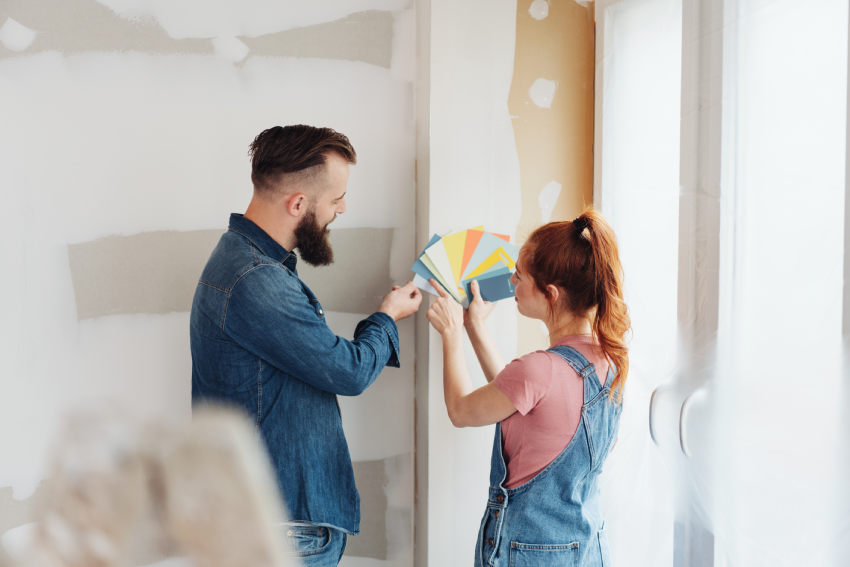House Painting Tips: Best Practices From an Expert
If you're looking for straightforward, no-fluff house painting tips, you're in the right place. At McHugh Painting, we've been painting homes across Kitchener, Waterloo, Guelph, and Cambridge since 2008. We’ve seen the good, the bad, and the "what were they thinking?" of house painting, and we’re here to help you avoid the last two.
Whether you're tackling a full exterior repaint or freshening up your cabinets, understanding the basics (and the not-so-basic) will save you time, money, and a lot of regret. Let’s get into it.
How Often Should You Repaint Your House?
There’s no one-size-fits-all answer, but here’s the baseline: interiors should be repainted every 5–7 years, and exteriors every 7–10 years. That said, how often should you repaint your house depends on several factors: your climate, the surface type, the quality of your last paint job, and how much wear and tear your walls take.
In high-traffic areas like hallways or kids’ bedrooms, repainting might be needed every 2–3 years. On the exterior, if your home takes a beating from snow, rain, or intense sun (hello, Canadian winters), you may need to freshen things up more frequently.
Pay attention to peeling, bubbling, or faded colour. These are all red flags. If your paint’s starting to flake, it’s not just a cosmetic issue, it’s a protective barrier that’s breaking down.
The Benefits of Repainting a House
Repainting a house is more than a cosmetic upgrade. It’s maintenance, protection, and value-building all in one bucket.
A good paint job does three things:
Protects your surfaces. Exterior paint shields your siding from moisture and UV damage. Interior paint can resist mould, dust, and stains.
Improves air quality. Low-VOC paints reduce indoor pollutants. Great for families, especially those with allergies or sensitivities.
Boosts property value. Fresh paint increases curb appeal. For resale? It’s one of the easiest ways to make your home stand out.
But the benefits don’t stop there. A well-timed paint job can actually extend the lifespan of your home’s structure. By sealing out moisture and preventing wood rot or rust, you’re avoiding costly repairs down the line. Think of it as insurance for your surfaces, only prettier.
There’s also the mental impact. Studies have shown that colour affects mood. Repainting can refresh not only your walls but also your mindset. A warm kitchen, a calm bedroom, a bright home office—it all adds up to how you feel living in your space.
For landlords or property managers, repainting between tenants not only increases appeal but also signals cleanliness and care. Tenants are more likely to treat a freshly painted space with respect, and in competitive rental markets, a well-maintained unit rents faster.
If you're investing in energy efficiency, repainting can support that too. Reflective exterior paints can help regulate indoor temperatures. Paired with good insulation, this contributes to lower energy bills and a smaller carbon footprint.
Lastly, repainting allows you to stay current. Trends change. Tastes evolve. That accent wall you loved a decade ago might be holding your space back now. A new coat of paint is one of the simplest, most affordable ways to modernize your home without a full renovation.
In short, repainting is one of the most powerful and underrated tools you have to protect, update, and enjoy your property.
Industry-Wide Painting Myths
Let’s bust some common painting myths that make our job harder and your results worse.
Myth 1: Primer is optional.
Primer is often viewed as a step you can skip to save time or money, but that shortcut rarely pays off. Primer isn’t just for covering up dark colours (though it does that well). It creates a consistent surface for your paint to stick to, prevents stains from bleeding through, and improves the overall finish. If you're painting bare drywall, raw wood, or over a glossy surface, primer is a must. Skipping it can lead to uneven coverage and paint that peels long before its time.
Myth 2: All paints are the same.
Not all paint is created equal. There’s a big difference between the $30 can at the hardware store and a high-end professional-grade product. The cheaper stuff might look good on the first day, but it won’t hold up to scrubbing, moisture, or UV exposure. Premium paints often offer better coverage, require fewer coats, and last longer, making them more cost-effective in the long run. At McHugh Painting, we only use quality products because anything less just doesn’t cut it.
Myth 3: You can paint over peeling paint.
You can, but don’t expect it to last. Peeling paint means your old paint layer has failed; and if you don’t fix the root issue (moisture, poor prep, or cheap paint), the new layer will fail too. Always scrape away peeling sections, sand down rough edges, and prime the area before repainting. Otherwise, you’re wasting paint, time, and money.
Myth 4: You can match colours perfectly without sampling.
Paint chips lie. The lighting in your home, the surface texture, and even how paint is applied all impact how a colour will look on the wall. Sampling a colour on your actual surface is the only way to get an accurate read. And remember: the same colour can look very different in natural daylight versus artificial light. Always sample. Always.
Myth 5: Two coats are always enough.
Most jobs do require two coats, but not all of them do. Sometimes, especially when covering dark colours, stains, or highly absorbent surfaces, a third coat (or an extra coat of primer) is needed. Trying to rush the job by stretching coverage leads to patchiness and premature wear.
Myth 6: Paint is waterproof.
Paint is water-resistant, not waterproof. It can slow water penetration but won’t protect against leaks or structural moisture issues. If you’re painting a bathroom, basement, or exterior wall, use paint suited for high-humidity or wet environments and fix any underlying moisture issues first.
Myth 7: You can paint in any weather.
Temperature and humidity matter a lot. Paint won’t adhere properly or cure well if it’s too hot, cold, or damp. That’s why we monitor conditions closely on exterior jobs. Rushing to paint in suboptimal weather often leads to cracking, peeling, and wasted effort.
Myth 8: Painting is an easy weekend job.
It might look simple, but professional-quality painting takes skill, patience, and the right tools. From prep to cleanup, each step matters. A rushed job almost always shows and it usually costs more to fix than to do it right the first time.
Common Painting Mistakes To Avoid When Painting Your House
Want your DIY job to look like a pro did it? Avoid these classic painting mistakes:
Skipping surface prep. Clean, sand, fill holes, and wipe down walls before you even think about opening a paint can. Paint adheres best to clean, smooth surfaces. Miss this step, and you’ll end up with peeling, flaking, or uneven paint that doesn’t last.
Using the wrong tools. Not all brushes and rollers are created equal. Cheap tools can leave behind brush hairs, streaks, or a blotchy finish. A quality angled brush will give you cleaner lines around trim and edges, and a high-density roller will provide even coverage. Match your tools to the type of paint and surface you’re working with.
Not using painter’s tape properly. Painter’s tape is meant to give you clean edges, but only if it’s applied correctly. Press it down firmly to prevent bleed-through, and always remove it while the paint is still slightly wet for a crisp line. Leaving it on too long can peel off your new paint when removed.
Painting in bad weather. For exterior jobs, humidity, rain, and extreme temperatures are your enemies. Even interior jobs can be affected: too much humidity can slow drying, and poor ventilation can trap odours. Check the weather forecast and room conditions before starting.
Overbrushing or overrolling. When paint starts to dry and you go back over it, you can create drag marks, streaks, and an uneven sheen. Apply paint with confidence, and don’t fuss with it once it begins to set. Let each coat dry fully before adding the next.
Not mixing paint properly. Paint separates over time. If you don’t stir thoroughly, you may get inconsistent colour or sheen. Mix each can well before and during use. If you're using multiple cans of the same colour, combine them in a larger bucket to ensure a consistent finish across all walls.
Skipping primer when it’s needed. While some high-quality paints include built-in primer, this doesn’t always cut it on porous surfaces, patched areas, or drastic colour changes. Use a dedicated primer when in doubt because it can save your topcoat.
Rushing between coats. Every can of paint has a recommended drying time between coats. Don’t ignore it. Painting too soon can cause the fresh layer to pull up the undercoat or result in uneven coverage. Be patient.
Not planning the order of painting. There’s a method to painting a room efficiently: start with the ceiling, then walls, then trim. This helps avoid splatters and keeps your work clean and consistent.
Neglecting clean-up and maintenance. Dirty brushes, improperly sealed paint cans, and leftover spills make your job harder the next time around. Clean tools immediately after use, and store leftover paint properly to make touch-ups easy later.
A little planning and patience go a long way. These mistakes might seem minor, but they can make or break your results.
How to Make Paint Last Longer
So, you’ve got a fresh coat. How do you keep it looking sharp? Here’s how to make paint last longer:
Prep thoroughly. A well-prepped surface holds paint better and longer.
Use high-quality paint. Cheap paint costs more in the long run.
Apply the right number of coats. Usually two. Don’t try to stretch one coat and call it done.
Clean regularly. Dust and grime wear down paint. Wipe walls gently with a damp cloth every few months.
Address damage quickly. Fix chips and scratches as they appear—before moisture and dirt sneak in.
Your paint is only as good as the surface it’s on. Take care of both.
Can You Paint in the Winter?
Can you paint in the winter? Yes—and no.
For interiors, winter can be a great time to repaint. The air is dry, and you can ventilate rooms with modern low-VOC paints. Bonus: contractors are usually more available in the colder months.
For exteriors? It’s tricky. Most exterior paints require temperatures above 10°C to cure properly. Cold weather slows drying, affects adhesion, and can lead to cracking or blistering. Some specialty paints are formulated for cold weather, but it’s still best to wait until spring if you can.
That said, if you have a heated garage or enclosed porch that needs freshening up? Winter is fair game.
Whether you're painting one room or an entire house, getting it right takes more than a brush and a bucket. These house painting tips are your shortcut to results that actually last. For professional help in Kitchener, Waterloo, Guelph, or Cambridge, reach out to McHugh Painting—we’re here to make your vision real, no stress required.
Call (226) 978-8152 for a free quote from our expert painters and save $500 on residential painting projects. Ask about our 7-year warranty and lifetime cabinet refinishing guarantee.
From prep to finish, these house painting tips will help you get the job done right—and enjoy the results for years to come. Contact us for more information today.



